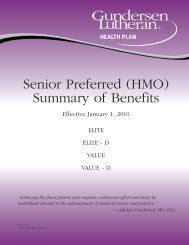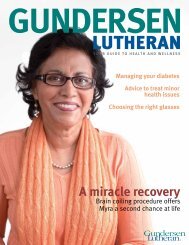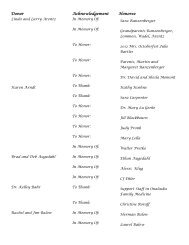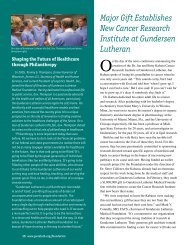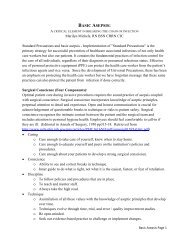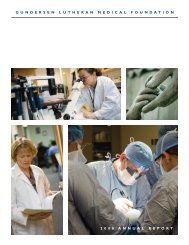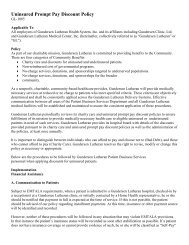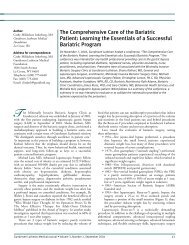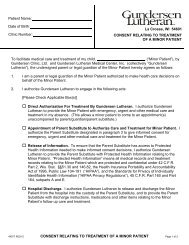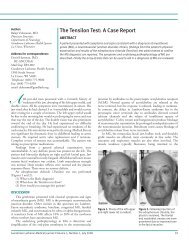Regional Report - Gundersen Health System
Regional Report - Gundersen Health System
Regional Report - Gundersen Health System
Create successful ePaper yourself
Turn your PDF publications into a flip-book with our unique Google optimized e-Paper software.
Skin cancer surgery aims to preserve healthy tissue<br />
Patients diagnosed with nonmelanoma skin cancer have<br />
another state-of-the-art option for treatment at <strong>Gundersen</strong><br />
Lutheran. Dermatologist Kurt K. Mueller, MD, offers an<br />
innovative surgical procedure called Mohs surgery.<br />
“About 95 percent of the skin cancers we see are<br />
nonmelanoma so having Mohs surgery available is a big benefit<br />
to patients in the area,” says Dr. Mueller, who is fellowship<br />
trained in Mohs surgery. “My goal is to get the highest cure rate<br />
while preserving as much healthy skin as possible.”<br />
As the only physician in the Tri-State Region performing this<br />
procedure, Dr. Mueller is committed to this goal. And the<br />
numbers show that he is living up to his promise. After<br />
performing more than 2,000 cases in the past three years, his<br />
patients have a cure rate of more than 98 percent. Similar cure<br />
rates have not been documented for other treatments.<br />
The Mohs procedure is a microscopically controlled skin<br />
cancer surgery. It is a preferred choice in areas where<br />
appearance and function are important such as the face, neck,<br />
hands, genitalia and lower extremities. The procedure is ideal<br />
for treating nonmelanoma skin cancers that have been newly<br />
diagnosed as well as those that have been treated but continue<br />
to recur.<br />
Dr. Mueller acts as the surgeon and pathologist during Mohs<br />
surgery. “I remove what appears to be the entire cancer. I then<br />
take a thin layer from the entire outside edge of the specimen,<br />
prepare a slide and examine the tissue under a microscope,”<br />
Dr. Mueller explains.<br />
Dr. Mueller uses a sophisticated mapping process so if he<br />
finds residual cancer cells in a part of the sample, he can go to<br />
the specific location and remove only the involved area. The<br />
process is repeated until the sample is clear of cancer cells.<br />
Mohs surgery is done under local anesthesia as an outpatient<br />
GreenLight PVP – continued<br />
develop irritative symptoms with increased frequency and<br />
urgency to urinate, obstructive symptoms such as slow stream<br />
and difficulty starting urination, or a combination of both.<br />
Compare the differences:<br />
Kurt Mueller, MD<br />
Specialty: Dermatology<br />
MD Degree: University of Nebraska College of<br />
Medicine, Omaha, Neb.<br />
Residency: National Naval Medical Center,<br />
Bethesda, Md.<br />
Fellowship: Northwestern Skin Cancer Institute,<br />
Chicago, Ill.<br />
procedure in Dermatology and patients can expect to spend up<br />
to half a day at the clinic. The skin sampling itself doesn’t take<br />
long, but after each sample is taken, there is about a 30 to 40<br />
minute wait as Dr. Mueller processes and examines it.<br />
“I prefer the Mohs procedure because I see the patient, the<br />
tumor, the defect left when the tumor is removed and the<br />
tumor under the microscope. One person acting as<br />
dermatologist, surgeon and pathologist eliminates many<br />
variables,” explains Dr. Mueller. “Mohs also takes away the<br />
guesswork of ‘blind’ procedures in which once the visible<br />
tumor is removed, we simply wait to see if it recurs.”<br />
In addition to Mohs surgery, <strong>Gundersen</strong> Lutheran offers<br />
Radiation and Medical Oncology, Plastic Surgery,<br />
Otolaryngology, Dermatopathology, Oculoplastic Surgery and<br />
Hand Surgery services. If a patient needs these services in<br />
conjunction with Mohs surgery, they can get them here as well.<br />
Dr. Mueller adds, “I’m happy to consult with clinicians who<br />
have patients they believe may be good candidates for Mohs<br />
surgery. By working together, we can deliver the best possible<br />
outcomes for patients.” Contact Dr. Mueller via MedLink.<br />
If you have patients experiencing symptoms of an enlarged<br />
prostate and could benefit from GreenLight PVP, call for a<br />
consultation or referral via MedLink.<br />
GreenLight PVP<br />
Traditional TURP<br />
• Laser coagulates blood as surgery is performed so there’s<br />
little risk of blood loss<br />
• Outpatient procedure<br />
• 45 minute to 1½ hour surgery<br />
• Limit physical activity for 3 to 4 days<br />
• Tiny risk of incontinence (less than 1 percent)<br />
• High risk of blood loss during and after surgery<br />
• Hospital stay of 1 to 3 days<br />
• 1 hour surgery<br />
• Limit physical activity for 2 to 4 weeks<br />
• Slight risk of incontinence<br />
Cost is comparable for both procedures; however, there is no hospital stay with GreenLight PVP.<br />
MedLink (800) 336–5465 4 In La Crosse 775–5465




